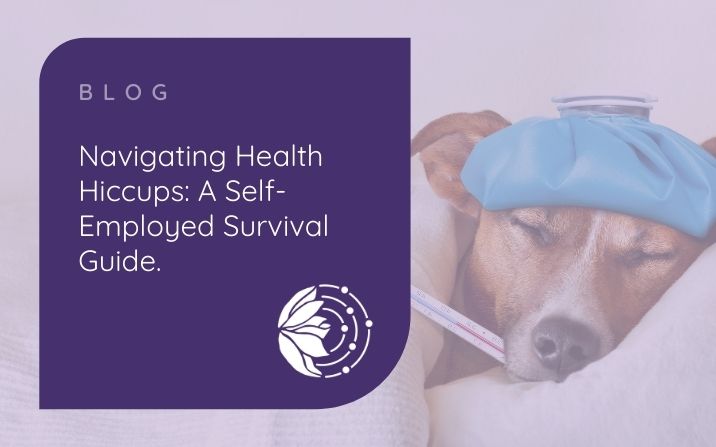Navigating Health Hiccups: A Self-Employed Survival Guide
In today’s fast-paced world, the hustle culture is often put on a pedestal, making it difficult for self-employed individuals like us to take a step back, even when our health is at stake. But let me tell you, powering through illness is not a sustainable strategy. Taking time off to rest and recuperate is not a sign of weakness; it’s a strategic move that can significantly benefit your future productivity.
Moreover, it’s crucial to have a contingency plan in place for those times when you might be out of action for a while. This isn’t a one-time task; it’s an ongoing process that involves creating a detailed plan that someone else can follow, ensuring that your business remains up and running, even when you’re not at the helm.
This comprehensive strategy should cover everything from client communication and project timelines to financial planning, to keep your business running well while you’re feeling less than your best.
Make the Best Use of the Technology You have Available to You
When you find yourself unwell, the immediate step is to convey your situation transparently to your clients and team. This means clear and concise communication that explains what’s going on, what will change as a result and when things should go back to normal.
Platforms such as Slack, Whatsapp, or even straightforward text messaging can be invaluable for this purpose. You can use these platforms to provide real-time updates on project statuses, potential delays and any rescheduling of meetings or deadlines.
This proactive communication strategy does more than just keep everyone informed; it sets the stage for how your business operates under challenging circumstances. It shows your clients and team that you have a plan and that you respect their time and commitment, even when you’re not at your best.
Moreover, technology can also help you automate certain tasks that would otherwise require manual effort. For example, you could use automated email responses to handle new client inquiries or set up project management software to send alerts to your team about upcoming deadlines. These automated systems can act as your virtual stand-in, performing routine tasks that free up human resources for more complex, urgent matters. Although it’s best to get these implemented now before you become ill and reliant on them!
The Art of Delegation and Prioritisation
Being self-employed often comes with the misconception that you must wear all the hats in your business. However, this mindset can lead to burnout, especially when you’re not feeling well. Delegation is not just a skill; it’s a necessity for sustainable business growth. When you’re under the weather, the ability to delegate tasks effectively becomes even more critical.
Firstly, it’s essential to have a well-documented process for your key tasks. This documentation should be so comprehensive that anyone stepping into your role should be able to pick up where you left off without a hitch. This is not merely about creating a to-do list; it’s about providing a step-by-step guide that includes the nuances and best practices that you would apply. This ensures that the quality of work remains consistent, even in your absence.
Secondly, delegation should be strategic. It’s not about offloading tasks randomly but about identifying which tasks can be best performed by others and which automated tools can handle routine activities. For instance, if you’re in the realm of digital marketing, tasks like data analysis could be handed over to a team member skilled in that area, while social media posts could be scheduled using automation tools. This frees you up to focus on high-level strategy and client relationships, which are areas that often require the business owner’s personal touch.
Alongside effective delegation comes the equally important task of prioritisation. When you’re not at your best, it’s crucial to reassess your to-do list through the lens of urgency and importance. The Eisenhower Matrix can be a useful tool here, helping you categorise tasks into four quadrants: urgent and important, important but not urgent, urgent but not important and neither. This exercise helps you gain clarity on what needs your immediate attention and what can be deferred or even eliminated.
Prioritisation is not a one-time activity but an ongoing practice that requires regular revisiting, especially when external factors like health come into play. It’s about making informed decisions on resource allocation, whether those resources are time, manpower, or financial investments. By focusing on what truly matters, you not only ensure that the most critical aspects of your business continue to function smoothly but also that you’re setting yourself up for quicker recovery and long-term success.
The Need for Rest and Contingency Planning
In a world where the hustle culture is often celebrated, the idea of taking a break, especially when you’re self-employed, can seem counterintuitive. However, pushing through sickness is not a badge of honour; it’s a recipe for long-term failure. Taking time off to rest and recover should be viewed not as a liability but as a strategic investment in your future productivity and by extension, the long-term success of your business.
Taking a break allows you the time to rejuvenate, both mentally and physically, which is crucial for creative thinking and problem-solving—skills that are indispensable in fields that require strategic planning, such as marketing consultancy. It’s not just about getting back to your old self but about potentially returning with a fresh perspective and renewed vigour, qualities that can enhance your business operations and client relationships.
While taking time off for immediate rest is crucial, it’s equally important to think long-term through contingency planning. This is not a task you tick off a list and forget; it’s an evolving strategy that needs regular updates. A robust contingency plan is comprehensive, covering various aspects of your business. It’s not just about who will handle your emails or attend client meetings in your absence; it’s about ensuring that your business can operate smoothly without you, even for a short period.
A well-thought-out contingency plan should include:
Client Communication: A protocol for informing clients about your unavailability and setting their expectations during your absence. This could involve automated messages or a trusted team member stepping in to handle communications.
Project Timelines: A clear roadmap for ongoing projects, outlining milestones and deadlines and identifying responsible team members for each task. This ensures that projects stay on track even if you’re not there to oversee them.
Financial Planning: Provisions for managing financial obligations like bills, payroll and client invoices. This could involve setting up automated payments or delegating financial responsibilities to a trusted team member or external service.
Documentation: A repository of essential business information, processes and contacts that someone can refer to in your absence. This should be easily accessible and regularly updated.
Review Mechanism: A periodic review of the contingency plan to update it based on new projects, team members, or business services. This ensures that the plan remains relevant and effective.
I go into much more detail about making a contingency plan for your business here.
In conclusion, being sick while self-employed poses a unique set of challenges that require a strategic approach to navigate successfully. By effectively using technology, mastering the art of delegation and prioritisation and understanding the importance of rest and contingency planning, you can ensure that your business thrives, even when you’re not at the helm.
These strategies align well with the principles of transparency, strategic planning and effective communication, which are cornerstones for any successful business, especially in the realm of marketing consultancy.
If you’d like to discuss anything I’ve covered in this blog, including how I can implement these strategies for your business, get in touch with me now for a complimentary call.

